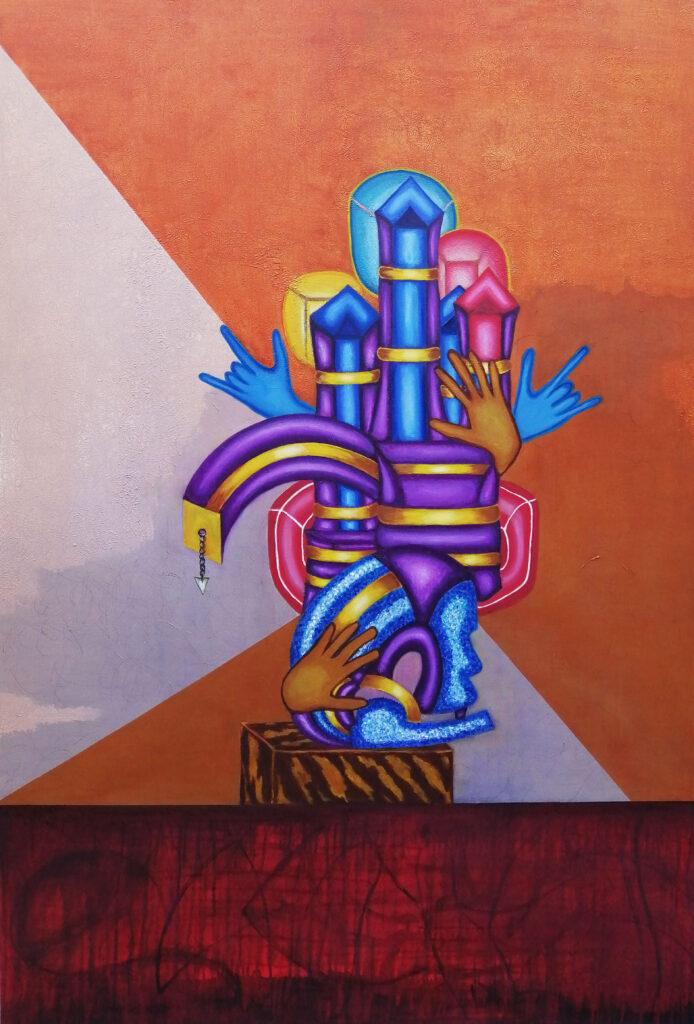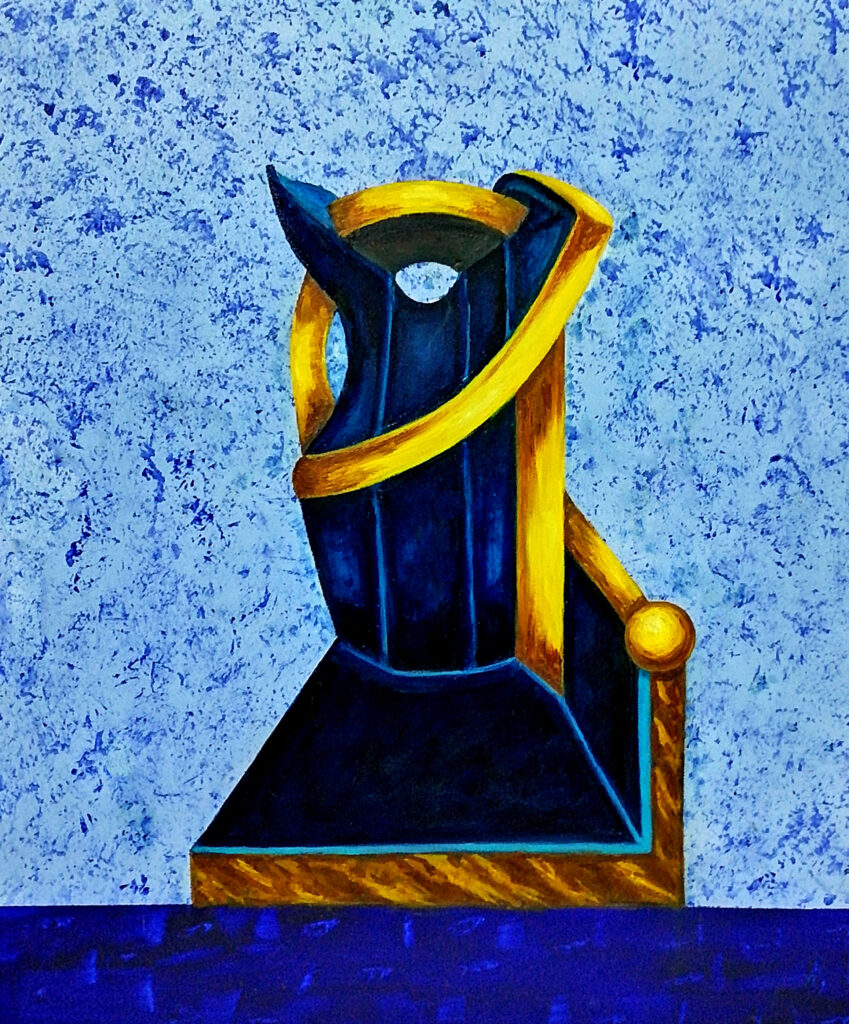About art Vincent van Gogh has said-
“The emotions are sometimes so strong that I work without knowing it. The strokes come like speech.”
And you will found similar quotes in devotion, the devotee surrender himeself and magic happen in life. So although art in itself is devotion (Bhakti) yet here we will talk about Bhakti (devotion) movement in Indian literature and then touch on a little in the visual arts.
Art is a continuous journey with civilization. Just as science invented many things and provided a lot of convenience to the people, similarly art helps in the development of the mind of the people and unknowingly it affects the society and culture. In ancient times people made some kind of tribal or folk type of paintings in caves or later in homes.

Modern art in western countries is known to be born around 14th century and in India from 19th century after Raja Ravi Verma: there was a revolution that came in painting’s world Printing press was established and the pictures of God and Goddess were accessible to general people. Jamini Roy, Nandlal Bose and many more artists were there who had contributed their part in Bhakti or devotional art. After that time, in art field, time came for modern art. In this time, like M.F. Hussain, Tyeb Mehta, Manjeet Baba and other artists came who took Bhakti in art to different level. They drew them differently and presented their unique style. After that, in contemporary world, Ganesh Pyne ,Atul Dodia and other artists came who had presented the pictures of God with different thoughts.In 1947, India became independent of British rule. A group of six artists – K. H. Ara, S. K. Bakre, H. A. Gade, M.F. Husain, S.H. Raza and Francis Newton Souza – founded the B
Bhakti or Bhakti in art in India is as old as the history of art. According to the scriptures (as they are the oldest writings), Brahma is believed to be the world’s first artist. We can find descriptions of paintings and sculpture in Vedic literature such as in the Bhagavata Purana, the story of the devotee Prahlad worshiping the deity of Lord Vishnu when Lord Vishnu incarnated as Narasimha. There is a story of Sita praying to Goddess Durga in Rama avatar. There are many such stories in ancient Indian literature in which deities are mentioned. However, there is a description of the painting of Aniruddha in the Mahabharata by Chitralekha and not much is known about the paintings other than this.
Here we will first try to understand the Bhakti Movement in literature –
Bhakti Movement
An important milestone in the cultural history of medieval India was the silent writing revolution in society brought about by a galaxy of socio-religious reformers, a revolution known as the Bhakti movement. The movement was responsible for many of the rites and rituals associated with the Hindus of medieval India (800–1700) and the Muslims and Sikhs.
The movement is traditionally regarded as an influential social revival and reformation in Hinduism, and offers a personal-centered alternative path to spirituality regardless of one’s birth or gender. The Bhakti movement started with the aim of reforming Hinduism. Postmodern scholars question this traditional view and whether the Bhakti movement was ever some kind of reform. He suggests that the Bhakti movement was a revival, reworking and re-reference of ancient Vedic traditions.
The texts of the Bhakti movement include the Bhagavad Gita, the Bhagavata Purana and the Padma Purana, etc.
As we have long neglected the achievements of the early civilizations in India because their secrets surround it from the Indus Valley (26 BC) to Mohenjodaro (2 BC).
Shankaracharya, the leader of the Hindu revivalist movement, was a great thinker and eminent philosopher.
Although the Bhakti movement originated in Tamil Nadu during the 6th to 8th centuries, spread northwards from Tamil Nadu through Karnataka, and gained widespread acceptance in Bengal and northern India in the fifteenth century. The Bhagavata Purana, the emphasis on devotion by the South Indian Alvar sages, has been attributed by many scholars to South Indian origin, although some scholars question whether this evidence excludes this possibility. Parallel development took place in other parts of the Bhakti movement. Like the Alvars, the Shaiva Nayanar poets were influential. Tirumurai, a compilation of rhymes on Shiva by sixty-three Nayanar poet-saints, developed into an influential treatise in Shaivism. Early Tamil-Shiva Bhakti poets influenced Hindu texts that were revered throughout India.
An important thread of Bhakti moment is the Radha Bhallabha sect which is based on Radha Krishna spiritual love. To this day in Brijbhumi you can find many murals and songs of this cult.
According to historian Wendy Doniger, the nature of the Bhakti movement may have been influenced by the daily practices of Islam “surrender to God” upon arrival in India. This in turn influenced devotional practices in Islam such as Sufism, and other religions in India from the 15th century onwards, such as Sikhism, Christianity, and Jainism.

This literature includes the writings of Kabir, Nanak (founder of Sikhism), Tulsidas, Nabha Das, Gusainji, Ghanananda,] Ramananda (founder of Ramanandi sect), Sripadaraja, Vyasatirtha, Kanakadas, Vijay Das, the six Goswamis of Vrindavan, Raskhan. Huh. Teachings of saints like Ravidas, Jayadeva Goswami, Namdev, Eknath, Tukaram, Mirabai, Ramprasad Sen, Sankardev, Vallabh Acharya Narasimha Mehta, Gangasati and Chaitanya Mahaprabhu. Writers from the 7th to the early 10th centuries are known to have influenced the poet-saint driven movement. Sambandar, Tirunavukkarasar, Sundarar, Nammalvar, Adishankar, Manikvakakar and Nathamuni. Several writers of the 11th and 12th centuries developed different philosophies within the Vedanta school of Hinduism, which were influential to the Bhakti tradition in medieval India. Include Ramanuja, Madhava, Vallabh and Nimbarka. These authors supported a spectrum of philosophical positions ranging from theistic dualism, qualified monism, and absolute monism.
Although the subject is very wide, but now we will stop it here briefly and discuss Bhakti in modern art.
Bhakti in Contemporary Art
Contemporary does not mean only the art of today but it is related to the generations who contributed their art in the past which belong to the present.
Modern art in western countries was born around the 14th century and in India from the 19th century after Raja Ravi Varma: there was a revolution in the world of painting
Printing presses were established and images of God and Goddess were accessible to the common people. There were artists like Jamini Roy, Nandalal Bose and many others who contributed to Bhakti or Bhakti art.
With the Swadeshi movement gaining momentum by 1905, Indian artists attempted to revive the cultural identity suppressed by the British, rejecting the Romantic style of the Company’s paintings and the attitudes of Raja Ravi Varma and his followers. It is thus known as the Bengal School of Art, led by the Asian styles (with an emphasis on Indian nationalism) of Abanindranath Tagore (1871–1951), known as the father of modern Indian art. Other artists of the Tagore family, such as Rabindranath Tagore (1861–1941) and Gaganendranath Tagore (1867–1938), as well as early 20th-century artists such as Amrita Sher-Gil (1913–1941), introduced the Western Styles in Indian Art.
After that came the time of modern art in the field of art. During this artists like M.F. Hussain, Tyab Mehta, Manjit Baba and others came to take devotion to a different level in art. He pulled them off differently and presented his own unique style.

After that, in the contemporary world, came Ganesh Payne, Atul Dodiya and other artists who presented images of God with different views.
In 1947, India became independent from British rule. A group of six artists – K.H.Ara, S.K.Bakre, H.A. Gade, M.F. Hussain, S.H. Raza and Francis Newton Souza – founded the Bombay Progressive Artists Group established new ways of expressing India in the post-colonial era. Although the group was disbanded in 1956, it had a profound influence in changing the idiom of Indian art. In the 1950s almost all the leading artists of India were associated with the group. Manushi Dey, V.S. Gaitonde, Krishna Khanna, Ram Kumar, Tyab Mehta, K.G. Subramaniam, A. Ramachandran, Devendra Singh, Akbar Padamsee, John Wilkins, Himmat Shah and Manjit Bawa are some of the famous people of today. There is so much diversity in Indian art today as never before. The most famous artists of the new generation include Bose Krishnamachari and Bikash Bhattacharya. Another prominent Pakistani modernist was Ismail Gulgee, who after Circa 1960 adopted an abstract phrase that combines aspects of Islamic calligraphy with an abstract expressionist (or gesture abstractionist) sensibility.
Painting and sculpture remained in importance in the second half of the twentieth century, although they often found new directions in the work of prominent artists such as Nalini Malani, Subodhgupta, Narayanan Ramachandran, Jitish Kallat, Vivan Sundaram. Bharti Dayal has chosen to handle the traditional Mithila painting in the most contemporary way and using her imagination has created her own style, they appear fresh and unusual.
The word contemporary has a broad meaning. Art and artists have always been influenced by devotion since the last 16th century. And we find that Krishna, Shiva and Lord Rama are being accepted as the guiding sources of the Indian art of Bhakti movement. Painting and sculpture are widely influenced by the Bhakti movement in our country from north to south and south to west. We find Krishna as the centre of the Bhakti movement in Indian culture and art.
It is not about any religion; it is complete surrender of oneself to which it is not important. When you are overwhelmed and want to express yourself, you need few words or lines, colours to express, although God is formless, still He have also a positive form. Many times artist describes Him as figurative or sometimes as formless. This is a great journey inward.
According to Roger Fry (an English painter and critic) in his famous Critical and Speculative Essays on Art – “Transformations”, ” how something is represented is more important not what is represented.”
Though being an artist, in my view art and devotion are similar, yet they differ only in certain practices as per aspiration. So there is this journey of knowing oneself through art from beginning to end and this is what is called Bhakti in art.
Riddhima
?if this blog is in anyway helpful to you or what is your opinion about this or on what topic you want to see the next blog – please comment below. ?
https://artistinterest.blogspot.com/2020/08/devotion-and-contemporary-art-in-india.html
https://artistinterest.blogspot.com/2020/08/devotion-and-contemporary-art-in-india_17.html


you’re in reality a excellent webmaster. The web site loading velocity is amazing. It sort of feels that you are doing any distinctive trick. Moreover, The contents are masterwork. you’ve performed a wonderful job in this topic!